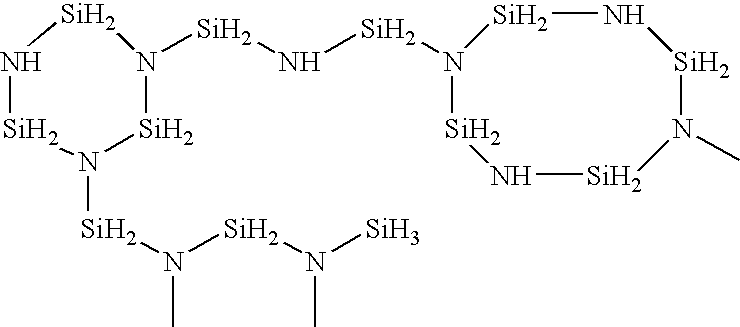Solvent for treating polysilazane and method of treating polysilazane with the solvent
a technology of polysilazane and solvent, which is applied in the direction of detergent compounding agents, dissolving, cleaning using liquids, etc., can solve the problems of clogging of waste liquor lines, cracks generated due to reduced thickness of formed films, and expensive apparatuses and complicated control for forming good coats, etc., to achieve good edge cutting ability and reduce the amount of particles
- Summary
- Abstract
- Description
- Claims
- Application Information
AI Technical Summary
Benefits of technology
Problems solved by technology
Method used
Image
Examples
reference example 1
Synthesis of Perhydropolysilazane
[0047]A 300-ml, four-necked flask was equipped with a gas-introducing tube, a mechanical stirrer and a Dewar condenser. After replacing the atmosphere within the reactor with deoxidized dry nitrogen, 150 ml of deaerated dry pyridine was placed in the four-necked flask, then ice-cooled. Subsequently, 16.1 g of dichlorosilane was added thereto over 50 minutes to generate a white, solid adduct (SiH2Cl2·2Py). The reaction mixture was ice-cooled and, under vigorous stirring, 10.9 g of purified ammonia through a soda lime tube and an activated carbon tube was bubbled into the mixture over 1 hour as a mixed gas with nitrogen. After completion of the reaction, a solid product was removed by centrifugal separation and filtration. The solvent was removed from the filtrate under reduced pressure (50° C., 5 mmHg, 2 hours) to obtain 5.52 g of a glassy, solid polysilazane. The molecular weight of the product measured by the vapor pressure depression method was 2,0...
reference example 2
Synthesis of Methanol-Added Perhydropolysilazane
[0048]Methanol-added perhydropolysilazane was synthesized according to Example 1 in JP-A-5-345826. The resultant methanol-added perhydropolysilazane contains the structure as shown below:
[0049]
reference example 3
Synthesis of Hexamethyl Disilazane-Added Perhydropolysilazane
[0050]Hexamethyl disilazane-added perhydropolysilazane was synthesized according to Example 1 in JP-A-4-63833. The resultant hexamethyl disilazane-added perhydropolysilazane contains the structure as shown below:
[0051]
PUM
| Property | Measurement | Unit |
|---|---|---|
| temperature | aaaaa | aaaaa |
| temperature | aaaaa | aaaaa |
| aniline point | aaaaa | aaaaa |
Abstract
Description
Claims
Application Information
 Login to View More
Login to View More - R&D
- Intellectual Property
- Life Sciences
- Materials
- Tech Scout
- Unparalleled Data Quality
- Higher Quality Content
- 60% Fewer Hallucinations
Browse by: Latest US Patents, China's latest patents, Technical Efficacy Thesaurus, Application Domain, Technology Topic, Popular Technical Reports.
© 2025 PatSnap. All rights reserved.Legal|Privacy policy|Modern Slavery Act Transparency Statement|Sitemap|About US| Contact US: help@patsnap.com



